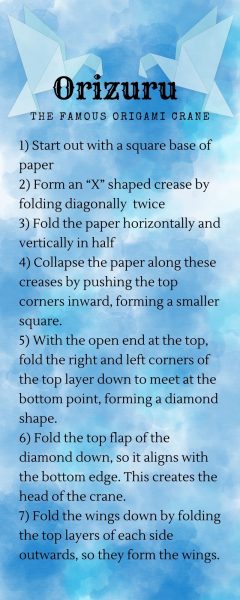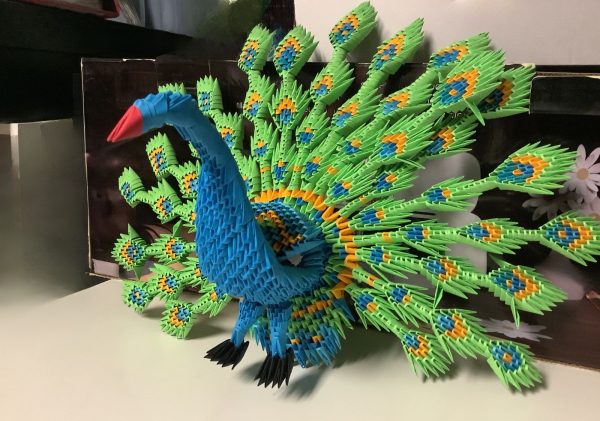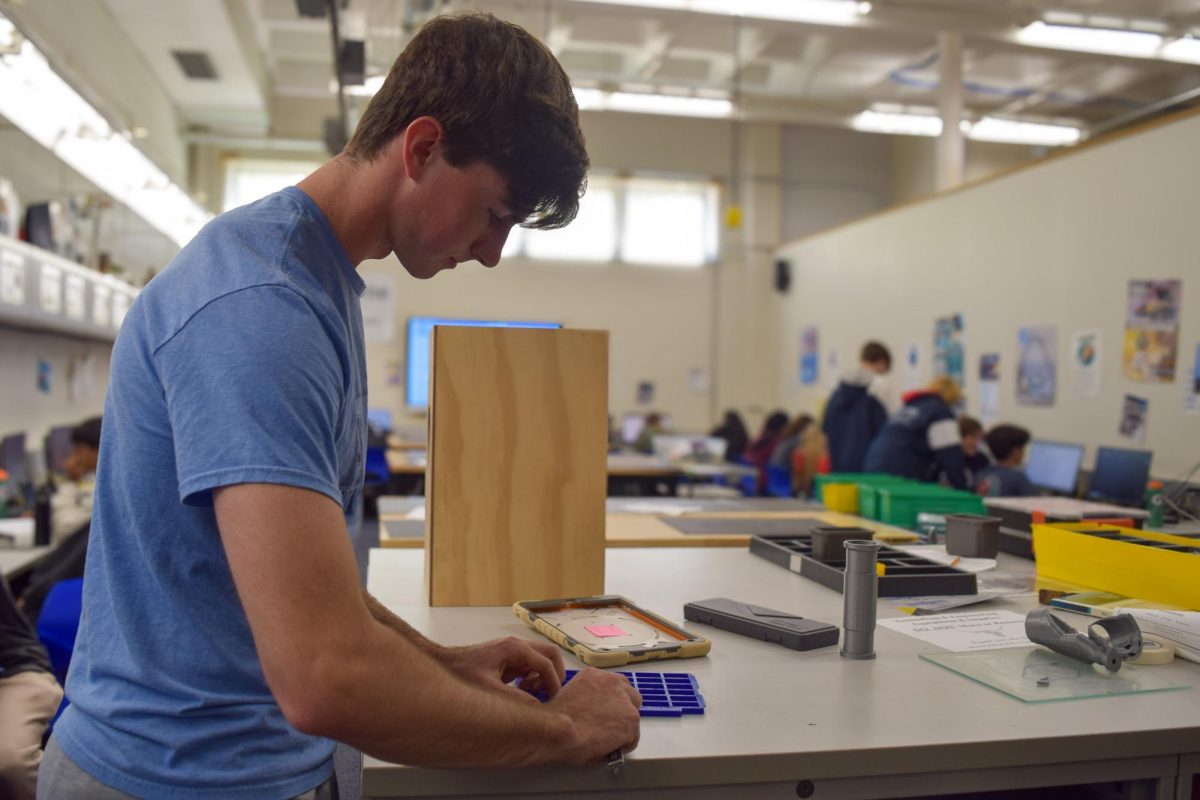
When a time of leisure arises in class, as students go on their phones or talk to friends or read a book, just one piece of paper and a sense of creativity can leave a student to casually experiment with art in the corner of the room. That art is the Japanese art of folding paper to form three-dimensional objects: origami, which has increasingly grown in popularity as a relaxing hobby.
Origami has existed since the 6th century, when it was first used to decorate temples and shrines in East Asia. It was only in the 1950s that the art, introduced by Lillian Oppenheimer, made its way to the western world. Oppenheimer popularized the Japanese term ‘origami’ in anglophone settings, allowing the activity to take modern American culture by storm. Today, renowned museums like the American Museum of Natural History and national organizations like Origami USA help to keep the art alive.
Following this revival of origami over the past decade, freshmen Cole Barton and Preston Priest have worked to expand upon their origami skills in Drawing 1 under the instruction of art teacher Kat Briggs. Briggs discovered Barton and Priest’s proclivity for origami when they fashioned origami flowers during their free time in art class.
“[Their] skills from origami really show off their spatial and visual abilities. When [students] make origami, they are engaging in their own art-making process,” Briggs said.
Barton first began practicing origami after his mom discovered a tutorial on Facebook when he was 8 years old. After following the instructions in the video, Barton’s interest in origami was sparked.
“Even though it was really hard, I enjoyed working on origami and learning from it. I binged videos and tutorials on it on YouTube,” Barton said. “Now, after years of practicing, I have memorized a lot of the techniques. I can fold and create a lot of things without using a tutorial, but some hard origami designs require me to search up videos at times.”
Similarly, Priest was around eight years old when he first discovered origami after visiting the Missouri Botanical Garden for the Japanese Cultural Festival.
“I tried to hone the craft by practicing a lot. I haven’t had a lot of in-school opportunities to practice or create origami, but often at home, I will make more challenging pieces,” Priest said.
Origami is particularly notorious for its steep learning curve with its emphasis on following step-by-step instructions and employing three-dimensional perceptual skills. Despite initial challenges with learning new folds and developing fine motor skills, Barton fervently practiced this skill. Eventually, he advanced enough to open up an origami stand to sell his artwork, raising over $250 in profit and donating $50 to charity.
“Origami is a precise art. It’s not just about folding paper; you have to be willing to try again and again. It tests your stamina and patience,” Barton said. “Origami has helped me understand the importance of

trying my very best. It is so easy to rush through things and not end up doing them properly. One misaligned fold can impact your end creation, so you need to take your time or you risk ruining everything. With origami, the key is in the details.”
Pries has gathered significant accomplishments in origami as well. Just a year ago, Priest won the Glory of Missouri Award for his origami artwork. Now, Priest sells his artwork to friends and family and hopes to eventually pursue origami professionally by setting up a website for origami art sales. He also aspires to write an origami instructional book when he is older.
“I appreciate Preston and Cole’s keen spatial abilities because they can understand and conceptualize in three dimensions, whereas I am much more comfortable in two dimensions with my experience in painting and drawing,” Briggs said. “I am excited to see where each of them take these skills next, whether it be in sculpture, ceramics or drawing classes here at West or beyond.”

![Freshmen Cole Barton and Preston Priest make origami flowers during free time in their Drawing 1 class. Both gained an affinity for origami through the internet and further practiced this art under the guidance of West High Drawing 1 teacher Kat Briggs. “Their origami pieces are especially intricate. Both use multiple small pieces of paper that fold and interlock, enabling their sculptures to move and also simulate textures. They also use very precise folds, and I appreciate the careful craftsmanship that [goes] into their art,” Briggs said.](https://pwestpathfinder.com/wp-content/uploads/2023/10/DSC_0019-2-copy-1-1200x800.jpg)




![Senior Adam Zerega stands with senior Dexter Brooks by farm equipment. Zerega often worked with friends and family on his farm. “I've been able to go to my family's farm since I was born. I [spend] at least three weekends a month [on the farm], so I'm there all the time,” Zerega said.](https://pwestpathfinder.com/wp-content/uploads/2025/04/IMG_4872-1200x900.jpg)

![Phage grown by senior Rio Naghibi Harat sit in petri dishes. Through Webster University, Naghibi Harat was given the opportunity to develop phage as a potential remedy for tuberculosis. “Phage are everywhere. I got mine from a soil sample. I'm not kidding; I picked [it] up from dirt. They're harmless, unless you code them to do something, and they can evolve. Virus antibiotics can't. They're one solid molecule. A strain of this bacteria [can evolve] that is resistant to [a] particular drug, [but] phage will evolve with the bacteria. They can see the changes, and they can be the change,” Naghibi Harat said.](https://pwestpathfinder.com/wp-content/uploads/2025/04/Flag-2.png)
![Hosting a meeting for Women’s History Month, co-president Bethany Liao converses with club members of Women in Healthcare. The event fostered discussions about women in medicine and included a third year medical student from Bosnia as a guest speaker. “Creating this club has been a net positive experience for everyone. After we present [or a guest speaker], we [also] usually have snacks for everyone and it gives people an opportunity to generally talk or discuss,” Liao said.](https://pwestpathfinder.com/wp-content/uploads/2025/04/DSC0032-1-1200x800.jpg)


![Scrolling on eBay, sophomore Ryder Williams searches the app for different shoe styles. Williams credits the impact his completion of business and finance courses have had to gain his financial success, as well as his Personal Finance teacher, Andy Croley. “Croley helped me a lot in getting to know more about profit and where to put the money. [He] also [taught me] how to store my money, ways to invest it [and] that I should always have emergency funds,” Williams said.](https://pwestpathfinder.com/wp-content/uploads/2025/02/ryder-fea-3-1200x800.jpg)


![Alongside club sponsors Andrea Horn and Tim Burkard, assistant principal Kate Piffel prompts a discussion at the first Black Student Union (BSU) meeting. She accepted suggestions for BSU from members like BSU Leader and junior Tanatswa Zirengani, who moved from Zimbabwe in 2021. “Moving here and transitioning into a new school [and] lifestyle, [BSU] became [a place] where I could be myself and talk about issues that I felt comfortable talking about back home. BSU [also] gave me the opportunity to venture into the post-high-school experience, telling me [some] things to expect,” Zirengani said.](https://pwestpathfinder.com/wp-content/uploads/2024/12/DSC_0120-1-1200x800.jpg)

![Junior TJ Polack plays his saxophone solo at halftime for the 2024 marching band show, ‘Coloring Book.’ This year, Polack was one of two soloists in the marching band. “[Polack] is very hard on himself. [His saxophone solo] sounds amazing [and] everyone [cheers] for him; [still], somehow, he thinks it’s a bad performance and he's down. What he does is not easy. It takes a lot of confidence as a person [and] a lot of musical skill to be expressive, and he's doing an amazing job,” drum major and senior Dominic Perez said. (Courtesy of Christina Block)](https://pwestpathfinder.com/wp-content/uploads/2024/11/462488499_2973926416100522_5057718068659607183_n-1200x925.jpg)

![Sophomore Isaiah Meese smiles after his Eagle Scout Ceremony. Meese has participated in the scouting program since first grade, learning new aspects of life and growing a community of a second family. “I almost didn’t do [boy scouting], but I'm glad I eventually did start doing it. I regret that I wasn't [working towards Eagle Scout during COVID]. It might not always seem like the most rewarding thing, but if you put your time into it, there's a good chance you'll get quite a lot out of it: friends, new activities and hobbies, or just more experience,” Meese said.](https://pwestpathfinder.com/wp-content/uploads/2024/10/IMG_1004-1200x800.jpg)
![Standing in front of the American Sign Language program’s mural, junior Brooke Hoenecke signs with freshman Darren Young. Hoenecke began cadet teaching for ASL this year alongside working towards earning her seal of biliteracy. “I was in ASL class when I received the email [that I qualified for the seal]. I was jumping up and down with my teacher and the rest of the class. One of the reasons why I took cadet teaching this year was so that I could prepare for the Seal of Biliteracy and be immersed in ASL,” Hoenecke said.](https://pwestpathfinder.com/wp-content/uploads/2024/05/hoenecke.jpeg)
![Walking onto the field, freshman Erastus Adewusi wears a pink jersey in remembrance of cancer awareness month. With the number seven on his jersey, Adewusi reflects on his life in Nigeria before moving to America. “I [used to wake up] at 5:30 a.m. and school would end at 5 p.m. [versus] now,” Adewusi said.](https://pwestpathfinder.com/wp-content/uploads/2024/05/DSC_0029-1200x800.jpg)

![Envisioning a cathedral in his mind, senior Soren Frederick puts pencil to paper and practices a rough sketch in the drawing room. Frederick grew up surrounded by a family of artists who helped him realize his passion for drawing and painting as he matured. “My family [is] very much [an inspiration] for drawing and painting. [Art] didn’t start [in the family] with me; it started with my mom and my older sister, and my older brother is very good at drawing [too],” Frederick said.](https://pwestpathfinder.com/wp-content/uploads/2024/05/DSC_0017-1200x800.jpg)


Mary A. • Oct 24, 2023 at 2:59 pm
Great work!
Lauren Holcomb • Oct 18, 2023 at 10:59 pm
THIS IS SO COOL WHAT